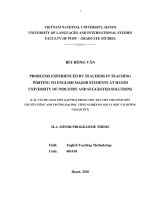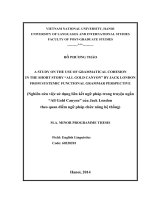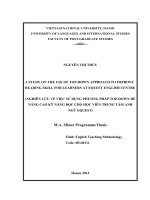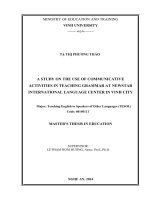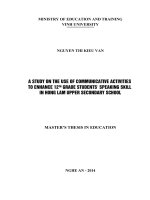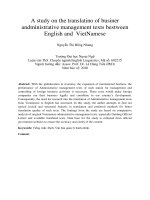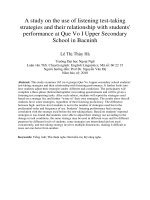A STUDY ON THE USE OF SITCOMS IN TEACHING SPEAKING TO ENGLISH MAJOR STUDENTS AT VINH UNIVERSITY
Bạn đang xem bản rút gọn của tài liệu. Xem và tải ngay bản đầy đủ của tài liệu tại đây (605.16 KB, 68 trang )
MINISTRY OF EDUCATION AND TRAINING
HUE UNIVERSITY OF FOREIGN LANGUAGES
------------
A STUDY ON THE USE OF SITCOMS IN
TEACHING SPEAKING TO ENGLISH MAJOR
STUDENTS AT VINH UNIVERSITY
MA THESIS IN THEORY AND METHODOLOGY
OF ENGLISH LANGUAGE TEACHING
In partial fulfillment of the requirements for the degree of Master of Arts,
Hue University of Foreign Languages
HUE, 2015
MINISTRY OF EDUCATION AND TRAINING
HUE UNIVERSITY OF FOREIGN LANGUAGES
------------
A STUDY ON THE USE OF SITCOMS
IN TEACHING SPEAKING TO ENGLISH
MAJOR STUDENTS AT VINH UNIVERSITY
MA THESIS IN THEORY AND METHODOLOGY
OF ENGLISH LANGUAGE TEACHING
CODE: 60.14.01.11
SUPERVISOR:
HUE, 2015
2
BỘ GIÁO DỤC VÀ ĐÀO TẠO
ĐẠI HỌC HUẾ
TRƯỜNG ĐẠI HỌC NGOẠI NGỮ
------------
NGHIÊN CỨU SỬ DỤNG CÁC TÌNH HUỐNG
HÀI KỊCH GIẢNG DẠY MÔN NÓI
CHO SINH VIÊN CHUYÊN NGÀNH TIẾNG
ANH TẠI TRƯỜNG ĐẠI HỌC VINH
LUẬN VĂN THẠC SĨ LÝ LUẬN VÀ PHƯƠNG PHÁP DẠY HỌC
BỘ MÔN TIẾNG ANH
MÃ SỐ: 60.14.01.11
NGƯỜI HƯỚNG DẪN KHOA HỌC:
3
HUE, 2015
4
STATEMENT OF ORIGINALITY
This work has not previously been submitted for a degree
or diploma in any university. To the best of my knowledge
and belief, the thesis contains no material previously
published or written by another person except where due
reference is made in the thesis itself.
Date: 3/ 8 / 2015
Signature
5
ABSTRACT
This study was set out to describe the implementation of using sitcom situation
in speaking class and explore how it influences on student’s motivation, language
proficiency.
The study used both quantitative and qualitative approaches in methodology.
A questionnaire was sent to 35 students who were at different level of English
.Interview data was also collected with 6 students; in addition, observation was
conducted in some classes.
Results highlight the complexity of How does using sitcoms make an impact
on student’s motivation? And what are the benefits of using sitcoms in oral skills?
The researcher shows that sitcoms indeed are great and useful tool for English
learners and for teachers of English as well. Moreover, persuasive figures in this
study demonstrated the great improvement of student’s English listening and
speaking proficiency after learning with sitcoms. Both teacher and students found
that sitcoms brought them completely new English learning experiences and they
seem satisfied with the sitcoms used classes.
Based on the findings of the study, the research gave some discussions,
conclusions and some suggestions for the future research.
6
ACKNOWLEDGEMENTS
I have been fortunate to receive invaluable help from many people during my
assignment. First, I would like to express my deepest gratitude to DR. , my teacher,
for his immense encouragement, whole hearted and detailed guidance, without
which the assignment could not have been completed.
My sincere gratitude goes to my teachers of the foreign language, Vinh
University for their practical knowledge through useful guidance which helps me a
lot in completing this study. Without their superior knowledge and experience, the
study would like in quality of outcomes, and thus their support has been essential.
I want to particularly express my deepest appreciation to Mr. Alex Porter for
his valuable suggestions and useful help.
I would like to show my special thanks to my students who help me a lot in
giving their invaluable comments and suggestions while the work of this
assignment was in progress.
Last but not least, I also owe my indebtedness to my family and colleagues
for their kind co-operation and encouragement which help us in completion of this
study.
Vinh, July 2015
7
TABLE OF CONTENTS
Contents
SUB COVER PAGE
STATEMENT OF AUTHORSHIP
ABSTRACT
ACKOWLEDGEMENTS
TABLE OF CONTENTS
LIST OF ABBREVIATIONS
LIST OF TABLES
8
Pages
LIST OF ABBREVIATIONS
S. W
: Stressed words
B. S. I .C : Stands for Before stress instruction class.
A. S. I. C : After stress instruction class
9
o
: A symbol for unstressed word
0
: A symbol for stressed word
LIST OF TABLES
LIST OF FIGURES, CHARTS
10
CHAPTER 1. INTRODUCTION
1.1.Background of the study
All of English major students at Vinh University had to spend at least 7 or 8
years studying English since elementary before enrolling the professional long term
English course, but most of them frequently failed to use English to communicate.
The reasons, which were pointed out, were the lack of exposure of students to an
English environment, they have few chances to listen to and speak in English, and
the speaking lessons were not motivated enough.
According to the input hypothesis and studies in second language acquisition,
a large amount of exposure to a language speaking and listening environment is the
key to a success in language learning (Hammond, 1898; Nicola, 1989; Nikolov &
Krashen, 1997; swaffer & woodruff, 1982; wolfe & Jones, 1982; Winitz, 1996,
cited in Krashen, 1997).
Over the past decade, there have been numerous workshops, journal papers on
the use of the authentic materials in language classroom in order to increase
learner’s motivation and effective learning. In her TESL journal, Christine Canning
Wilson mentioned that “Video is at best defined as the selection and sequence of
messages in an audio-visual context. Considerable confidence is placed in the value
of audio-visual aids to enhance the learning of foreign languages”. Arthur( 1999)
claims that : “ video can give students realistic models to imitate for role-play , can
increase awareness of other cultures by teaching appropriateness and suitability,
can strengthen audio/visual linguistic perceptions simultaneously, can widen the
classroom repertoire and range of activities, can help utilize the latest technology
to facilitate language learning, can teach direct observation of paralinguistic
features found in association with the target language, can be used to help when
training students in ESP related scenarios and language, can offer a visual
reinforcement of the target language and can lower anxiety when practicing the
skill of listening”. At the workshop “ Short and sweet: using short films to promote
creativity and communication” , Kieran explores how short films can be used in the
11
classroom, and how we use it to promote creativity , and both oral and written
communication by doing communicative activities based around a variety of short
films.
Moreover, in term of learner motivation with videos, a number of studies and
journals have shown that “video appear to be more interesting to students so that
they are likely to become actively involved in the lesson” (Chiang, 1996, 1997; Lin
& Fox, 199a; Lin, 2002a; Lo, 2004).
Stephen Ryan in his journal on “using films to develop learner motivation”
says that “Students will often express an interest in using movies as a medium for
language learning.”
Furthermore, psychologists say that a film is great when it reflects a person’s
own values. In another word, great films help us discover our personal values, when
you have a strong feeling while watching movies, you may see personal value
inside of you that movie is reflecting. Movies can teach you a lot about you self.
Sineta (1993) claims that “Films can be consciousness-raising tools; their stories
are personal mentors that lessen fear or illuminate the love, virtue, and wholeness
already present in our lives”.
It can be seen that, students will have a great motivation if they have chance
to study with films in class, and the teachers will have a very new and exciting
teaching experience as well comparing to using traditional textbooks.
It goes without saying that Film is one of the greatest authentic tools of
teaching English in class. Freda Mishan claims that “any teacher who has used a film
with learners will have felt the thrill of excitement in the class, the learners’
anticipation of entertainment and enjoyment at the sight of the VCR. Of all the
cultural products discussed here, film is the one that is designed to appeal most
directly and fully to our emotions.” In the context of ESL of ESL/EFL teaching,
abundant studies have recognized the importance of using videos to enhance learner’s
listening comprehension and to train student’s oral skills (Baltova, 1994; Chung &
12
Chiao, 1999; Lin, 2000a, 2002a; Lo, 2004; Markham, Peter, & McCarthy, 2001;
Secules, Herron, & Tomasello, 1992; Synder, 1988, cited in Hui-Ying Bai, 2008)
Explore sitcoms, which are a powerful source of authentic language with a
reference to the cultural back ground of characters, in teaching and improving student’s
English listening and speaking proficiency would be the main aim of this study.
1.2.Purpose and questions of the study
This study aimed to describe the implementation of using sitcom situation in
speaking class and explore how it influences on student’s motivation, language
proficiency.
The following research questions were guided by the mentioned purposes.
1. How does using sitcoms make an impact on student’s motivation?
2. What are the benefits of using sitcoms in oral skills?
How do sitcoms increase student’s motivation?
How do they increase student’s oral skill?
How do they have to develop oral skill?
1.3.Definition of terms
1. Sitcom
According to Oxford Advanced Learner’s Dictionary, “A regular programme on
television that shows the same characters in different amusing situations”
2. Motivation
“Interest in and enthusiasm for the materials used in class, persistence with the
learning task, as indicated by levels of attention or action for an extended duration;
and levels of concentration and enjoyment”
(Crookes & Schmidt, 1991)
3. Authentic materials
Materials designed for native speakers for real purposes rather than language
“invented” by linguistics and textbook writers (Baddock, 1996).
4. The input hypothesis.
13
Which applies only to language acquisition and not to language learning, posits the
process that allows second language learners to move through the predictable
sequence of the acquisition of grammatical structures predicted by the natural order
hypothesis. According to the input hypothesis, second language learners require
comprehensible input, represented by i+1, to move from the current level of
acquisition, represented by i, to the next level of acquisition. Comprehensible input
is input that contains a structure that is “a little beyond” the current understanding—
with understanding defined as understanding of meaning rather than understanding
of form—of the language learner (Krashen, 1982).
5.
The affective filter hypothesis.
This hypothesis states that “language learning must take place in an environment
where learners are ‘off the defensive’ and the affective filter (anxiety) is low in
order for the input to be noticed and gain access to the learners’ thinking”.
(Krashen, 1982)
1.4.Significance of the study
Creating an exciting environment , having all students get involved in the
activities and helping students have same amount of speaking time in class is not
easy for any English teachers. And, the use of authentic materials in an EFL
classroom has been discussed in recent years by many teachers who are teaching
foreign languages. Some persuasive voices insisting that English presented in
classroom should be authentic, full of cultural values and should be in funny ways.
Thanks to this study, exploring sitcoms in teaching speaking gave students great
experiences and improvements, teachers would have more options in speaking class.
1.5.Summary
This study aimed to describe the implementation of using sitcom situation in
speaking class and explore how it influences on student’s motivation, language
proficiency. The researcher aimed to emphasize the crucial and important role of
using video material in the areas of student’s motivation, speaking and listening
skills. Moreover, both students and teachers would gain an in-depth understanding
14
of the culture of some native English speaking countries in funny ways. The next
chapter will present literature review of the use of videos in language teaching.
CHAPTER 2. LITERATURE REVIEW
2.1 Authenticity material in language teaching and motivation
2.1.1 Authenticity/ authentically material
According to Freda Mishan “it is perhaps incumbents to deal at the outset
with the issue of adopting terms like authentic and authenticity, so weighted by the
value judgments implicit in their gloss as real, genuine, bonda fida, pure. Such
value judgments have meant that authentic materials and authenticity are naturally
appealing proposition of language practitioners and learners alike”. Authentic
material, which provides a real world communication and real contexts in daily life,
is very suitable for language classrooms. Thanks to TV and Internet, authentic
material can be found easier than before. News, documentaries, talk show, reality
show, movies, drama series, etc., are such valuable authentic material.
Furthermore,
Omaggio – Hadley (1986) insisted that one of the important
principles of communicative language teaching is that authentic language should be
used in instruction whenever possible.
A comparative study of authentic video material and traditional curriculum
for teaching listening in U.S.A was conducted by Secules, Herron, and Tomasello
(1992) revealed that the video group demonstrated considerably greater listening
comprehension than the group without videos in results.
As students learn to enjoy watching video materials, they will eventually
seek out more of their own time watching for their own pleasure, and their English
will improve as a by-product of their enjoyment (Hwang, 2005; Katchen, 1996;
Krashen, 1997, cited in Hui – ying, Bai)
Using authentic materials is one of the mainstays of an imaginative and
motivating higher level course, and it benefits both students and teachers.
15
Martinez (2000) said that “by using authentic materials in the classroom, even
when it is not an authentic situation, it still provides the learners with many
significant advantages” He also summarized several benefits of using authentic
materials. The first one is that by using authentic material, students are exposed to
real discourse. Secondly, authentic materials keep students informed about what is
happening in the world. Thirdly, as language change is reflected in the materials so
that students and teachers can keep abreast of such changes. Fourthly, reading texts
are ideal to teach/practice mini-skills such as scanning. Fifthly, different authentic
materials such as books, articles, newspapers, and so on contain a wide variety of text
types, and language styles not easily found in conventional teaching materials. Lastly,
authentic materials can encourage reading for pleasure because they are likely to
contain topics of interest to learners, especially if students are given the chance to
have a say about the topics of kinds of authentic materials to be used in class.
2.2 Motivation
Peacock said that “for this study ‘motivation’ is defined… [as] interest in and
enthusiasm for the materials used in class; persistence with the learning task, as
indicated by levels of attention or action for an extended duration; and levels of
concentration and enjoyment”.
Needless to say, the motivation factor is one of the key justifications for the
use of authentic texts for language learning.
2.2.1 Gardner's motivation theory
Traditionally, motivation is distinguished as stemming from as desire either
to integrate with the target language community (integrative motivation) or to
achieve a practical goal ( instrumental motivation) by Gardner and Lambert.
16
FIGURE 2.1 Gardner and Smythe’s Model of Motivation (1975)
This model were proposed by Gardner and Smythe (1975), and the extension
of theoretical interpretations provided by Lambert (1963, 1967, 1974) and Carroll
(1962). This model was based on three elements: effort spent, motivation to
achieve, enjoying the task.
2.2.2 The Dornyei- Otto process –oriented model of L2 motivation
Developed by Dorney and Otto ( 1998) , the language learning motivation is
considered as “ a dynamic factor that displays continuous fluctuation,” in the
process model of L2 motivation, changing over time, and not as a static attribute in
other exitsting models of L2 motivation ( Donyei, 2005, p.83)
17
(Adapted from Attitudes, Orientations, and Motivations in Language Learning:
Advances in Theory, Research, and Applications. )
FIGURE 2.2. A Process Model of L2 Learning Motivation
There are 3 stages in a process model of L2 Learning Motivation, preactional
stage, actional stage and postactional stage. They are viewed in two dimensions:
Actions sequence and Motivational Influences. The action sequence was elaborated
by Dornyei and Otto (1998) as follows.
1. Preactional stage
First, motivation needs to be generated – the motivational dimension related
to this initial phase can be referred to as choice motivation, because the generated
motivation leads to the selection of the goal or task that the individual will pursue.
2. Actional stage
Second, the generated motivation needs to be actively maintained and
protected while the particular action lasts. This motivational dimension has been
18
referred to as executive motivation, and it is particularly relevant to sustained
activities such as studying an L2, and especially to learning in classroom settings,
where students are exposed to a great number of distracting influences, such as offtask thoughts, irrelevant distractions from others, anxiety about the tasks, or
physical conditions that make it difficult to complete the task.
3. Postactional stage
There is a third phase following the completion of the action – termed
motivational retrospection – which concerns the learners’ retrospective evaluation
of how things went. The way students process their past experiences in this
retrospective phase will determine the kind of activities they will be motivated to
pursue in the future.
(Dornyei & Otto, 1998, p.84)
2.3. Sitcoms and language teachings.
2.3.1. Sitcoms and motivation
Motivation is one of the most important factors in determining successful
second-language acquisition. Films and TV shows are an integral part of students’
lives so it makes perfect sense to bring them into the language classroom. Film, as a
motivator, also makes the language learning process more entertaining and
enjoyable.
Since watching sitcoms in free time is more and more popular among
teenagers and adults, in English class, sitcoms are great tool for English teachers. If
Students often feel sleepy or bored dealing with traditional textbooks, sitcoms will
give both students and teachers new exciting experiences. Markéta Hlozková claims
that “Another motivational factor in learning English via sitcoms is the challenge
and the sense of achievement connected with exposure to the authentic language.
Furthermore, sitcoms are powerful means for supporting students in autonomous
and lifelong learning”. Students are exposed to authentic English in real medial
intended to native speakers in real situations in daily life. In order to understand
what is happening on the screen and what makes people laugh out loud, and enjoy
19
sitcoms as native speakers , students have to know more information about the
content by getting more knowledge about vocabulary, grammar structures, and
culture as well as get involved in activities based on sitcoms by teachers in class.
According to Stempleski and Tomalin “ Incorporating communicative
activities based on the content of the video can encourage a more interactive
classroom, one in which the students are pushed to communicate what they have
seen and heard in order to complete the task at hand. Video provides foreign
language learners insight into the culture of the target language, and allows for the
opportunity to question any non- verbal aspects of communication that they may
not be familiar with. Video can lead to such cross-cultural comparisons to be
made.”
By using sitcoms in class, students will be enthusiastic about a target culture
or to achieve native speakers ‘understanding of English. Learner can learn English
in the most comfortable and enjoyable way.
2.3.2 Sitcoms and humor in the language classroom.
Humor and laughter play important parts in our life and in the English
classes either. By exploiting sitcoms, humor will be a useful tool to help learners
overcome the psychology barrier in classes so they can freely and comfortably get
involved in activities given by teachers, because a positive environment in
classroom may be more effective and beneficial than a strict and serious one.
Thanks to its humorous nature, active watching sitcoms in the English lessons may
enhance and intensify student’s learning (Markéta Hlozková, 2013).
Moreover, when college students are asked to identify what makes a good
instructor, among the first characteristics noted is a sense of humor. Students often
remember their favorite instructors as being those who created a fun environment
and made them laugh. Fun is one of the five primary needs of humans alongside
survival, belonging, power, and freedom (Pollak and Freda, 1997). A survey of 923
college, high school, and junior high school students asked whether they preferred
instructors who used humor in the classroom. Results have shown that 84% of these
20
students truly enjoyed instructors who used a regular to frequent amount of humor
(check, 1997).
The sitcom is a powerful means for teaching and learning English through
humor, in order to understand the sitcom, students have to learn about culture of the
target language and get more understanding about the humor of the culture.
However, not everything which is funny in sitcoms is appropriate and suitable for
students. Some of them can cause misunderstanding or offensive, rude. For
example, some joke or funny scenes about sex, poor people, the ugly, belief,
religion may hurt students’ feeling ; unintentionally, if teachers don’t take in to
account student’s conditions and have right choices.
Humor not only brings students get closer in class but it also is regarded as a
valuable educational tool. According to Markéta Hlozková “English learning and
teaching via authentic humor in sitcoms is like an inseparable infinite circle, when
the language and culture are taught through humor, and vice versa”
(Adapted from sticoms as a Tool for English language Teaching)
FIGURE 2.3. Infinite circle of humor, culture and language.
2.3.3 Sitcoms and culture
It might be impossible for all English learners to travel to English speaking
countries in the world to work or study; Sitcoms like a bridge that help learners
encounter various attitudes, beliefs and ways of life of the English speaking
21
countries. It goes without saying that sitcoms are a valuable source of a cultural
reference.
Ramona Tang in his article on “The Place of culture in the Foreign Language
classroom” claims that Language is culture. Language is the soul of the country and
people who speak it.
He also mentions the question “how much of the culture of a country should
be taught along with the language?” Teachers often spend a little time at the end of
the class to introduce a piece of the culture for students, it could be a song, a
traditional dance, festival; however, that will be not enough. To speak a language
well, one has to be able to think in that language. But, not all learners are
particularly lucky; they get a chance to spend some time to immerse themselves in
the culture of the English speaking country. By exploiting sitcoms in class, both
students and teachers can immerse in the culture for a certain amount of time.
Studying culture motivate students to study the target language as well as rendering
the study of the second language meaningful.
“Teaching English as culture means showing the students how grammar
and vocabulary express, construct and are a metaphor for the social and cultural
reality of an English-speaking world (Halliday, 1978; Kramsch, 1998), and how
idiomatic expressions say something about the general mindsets and beliefs of
native speakers of English (Lakoff & Johnson, 1980)” (cited in language, culture,
and voice in the teaching of English as a foreign language; Claire Kramsch).
Moreover, Garza claims that “learning a language in isolation of its cultural roots
prevents one from becoming socialized into its contextual use. Knowledge of
linguistic structure alone does not carry with it any special insight into the
political, social, religious, or economic system”.
An English learner can master a large amount of vocabulary, and excellent
at English grammar, that can’t guarantee himself a good communication
performance, if he doesn’t know anything about the target culture.
22
Learners can have a great opportunity to learn more about the culture of
English speaking country in sitcoms, which means, they know more about the
language. “The more we know about the culture of the language we are learning –
the better our understanding of that language will be” ( Bilsborough, “ sitcoms as a
Tool for ELT” ).
The fact is not all the text book contains the supportive materials for teaching
culture, to guide students to the real English speaking world, to motivate students to
learn the target language, teachers should use sitcoms as a tool in English class.
2.3.4 Sitcoms and pragmatics
An English learner is great at vocabulary and grammar; he may have a
meaningful conversation when interacting with native speakers. The dialogue can
be understandable, enough to communicate with simple purposes, however, English
can be used wrong in some different and specific contexts. Unfortunately, the
course books today do not supply learners of English with real daily life
conversations, sitcoms are one of the most effective tools help students to learn
pragmatics in a context.
According to Markéta Hlozková “pragmatics deals with the ways of people’s
communication and interpretation of intensions. It also focuses on ways of
appropriate use of the language in various situations depending on relationship
between the participants, the setting and the context of the situation. Pragmatics
operates at the level of meaning and how other people understand those meaning in
spoken conversations”.
Pragmatic competence is a crucial part in speaking; however, teaching
pragmatic in speaking classes is being neglected. Moreover, course books can’t help
students or teachers in term of pragmatic when providing artificial and direct
conversations without real context. As a result, students can’t use the target
language accurately and appropriately in different situations and contexts.
Using sitcoms in class, students can obtain more knowledge about pragmatic
competence. Sitcoms provide real conversations and speech acts in certain situation.
23
Furthermore, students can learn the non-verbal communication which plays 93% of
all daily communication. The body language, postures, gestures, facial expression
and eye contact will be introduced simultaneously with the language by the face to
face conversation scenes in sitcoms. Thanks to it, students can learn how to produce
the conversations and use non-verbal communication as native speakers.
Markéta Hlozková states that “thanks to watching sitcoms, learners of
English also realize that a casual dialogue does not insist on perfect fluent non –
interruptive utterances. By contrast, such conversations are full of repetition,
hesitation, pauses, overlaps, false starts and back- channels”.
Sitcoms are great sources and valuable authentic material of teaching
pragmatic in English class. Students can approach the right authentic English in the
most comfortable way.
24
CHAPTER 3. METHODOLOGY
3.1 Methodology
Based on the purpose of the research , describing the implementation of using
sitcom situation in speaking class and explore how it influences on student’s
motivation language proficiency . The methodology of the current study adopted
qualitative method and quantitative method . John (2006) clarifies that Qualitative
Research is collecting, analyzing, and interpreting data by observing what people do
and say. Whereas, quantitative research refers to counts and measures of things,
qualitative research refers to the meanings, concepts, definitions, characteristics,
metaphors, symbols, and descriptions of things.
Bawden (1990) defines qualitative data as studying the behavior of
individuals in all the complexity of their real-life situations. In contrast to
quantitative data, qualitative data does not simply count things, but is a way of
recording people's attitudes, feelings and behaviors in greater depth.
And the following research questions were guided by the aforementioned purpose:
1. How does using sitcoms make an impact on student’s motivation?
2. What are the benefits of using sitcoms in oral skills?
How do sitcoms increase student’s motivation?
How do they increase student’s oral skill?
How do they have to develop oral skill?
3.2. Theoretical Framework of the research
This study took phenomenological perspective to approach the teacher’s and
students’ perspectives toward the sitcom-based instruction qualitatively. Dr. Janet
Waters states that “The goal of qualitative phenomenological research is to describe
a "lived experience" of a phenomenon. As this is a qualitative analysis of narrative
data, methods to analyze its data must be quite different from more traditional or
quantitative methods of research.”
25

